A bathtub spout can last for many years depending on its quality among other factors. Nonetheless, at one point or another you will need to replace it. To do that you will first need to know the type of bathtub you have.
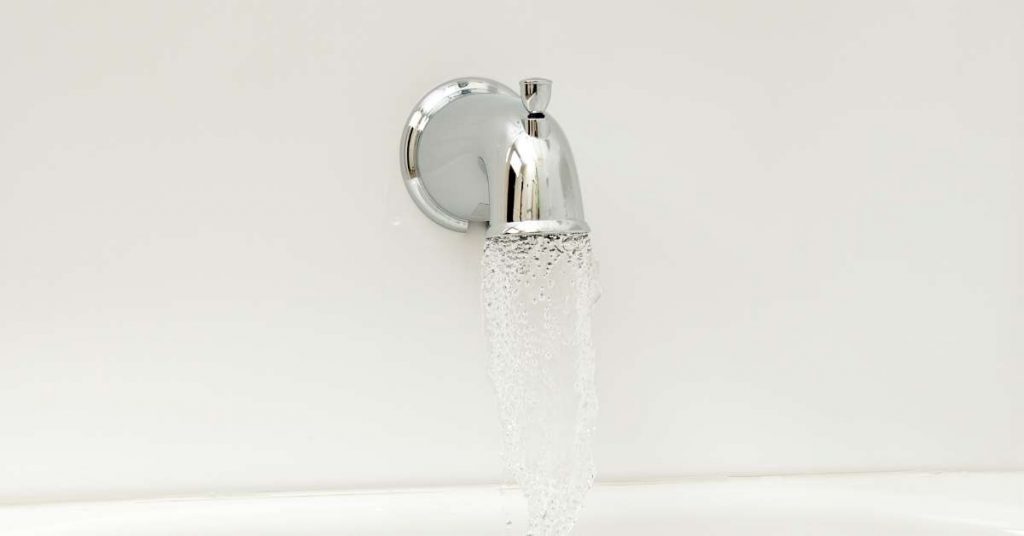
Bathtub spouts are categorized according to how they are installed, their appearance, how they are used, size and material used to make. Removing and replacing a bathtub is a fairly simple process provided you have the right type with you.
The different types of bathtub spouts are:
- Wall-Mounted Spout: These spouts are mounted on the bathroom wall and are the most common type. They come in various styles, including traditional, contemporary, and waterfall designs.
- Deck-Mounted Spout: Deck-mounted spouts are installed on the rim of the bathtub. They often have a handheld showerhead attachment for added convenience.
- Freestanding Floor-Mounted Spout: These spouts are mounted on the floor next to a freestanding bathtub, offering a sleek and modern look. They usually have a long, arching design.
- Diverter Spout: Diverter spouts have a pull-up or push-button diverter feature that allows you to divert water flow from the bathtub spout to a handheld showerhead or a fixed showerhead.
- Waterfall Spout: Waterfall spouts are designed to create a cascading water flow, resembling a natural waterfall. They provide a unique and luxurious bathing experience.
- Slip-On Spout: These spouts are designed to slip onto the existing pipe without requiring any special installation tools. They are a budget-friendly option for quick updates.
- Swing Nose Spout: Swing nose spouts have a movable spout that can be swiveled to direct water flow in different directions, offering flexibility in water delivery.
- Roman Tub Filler: Roman tub fillers are often used in large, freestanding bathtubs. They are typically deck-mounted and can provide a high flow rate for quick filling.
In this post however, we will only look at the common types os tub spouts.
A diverter spout can either be a slip-on or threaded, and the same thing goes for non-diverter spouts. Diverter and non-diverter tub spouts are the easiest to tell apart.
Brass-adapted bathtub spouts can either be slip-on, threaded, diverter or non-diverter. A brass adapter is screwed, threaded or soldered to the pipe extending from the wall and then the spout is connected to the adapter.
What Type Do You Have?
Look for a little knob at the top of your spout, and then bend over to see if you will see a screw underneath it.
If you see a small knob at the top of the bathtub spout, you have a diverter bathtub. Lack of a knob indicates that you have a non-diverter tub spout. If your spout is connected to the water supply pipe using a small screw underneath it you have a slip-on spout, otherwise you have threaded spout.
Seeing the screw under the tub might not be easy so you might need to bend and look keenly. Grab a flashlight and check under and at the back of spout. You can also use your finger to feel the groove where the screw is located.
A bathtub spout with a brass adapter is not easy to identify. You need to yo remove the spout to know if indeed you have an adapter or no.
It is very important that you order the same type of spout as the one you have in your bathtub. Buying any other type will simply not work.
Types of Bathtub Spouts
Let us now look at the different types of bathtub spouts in more details. Some types of bathtub spouts like the threaded tub spouts have other categories that you need to know but we will get to that soon
1. Diverter Bathtub Spouts
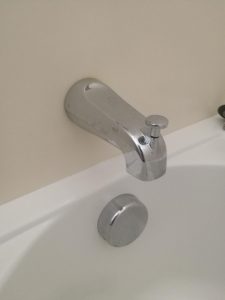
Diverter bathtub spouts are the bathtub spouts you see in bathtub-shower-combinations. There is a knob at the top of the spout for diverting the water from the tub spout to the shower head. But how does a diverter bathtub work.
The little knob at the top of the spout is connected to another piece inside the spout that works like a gate. There are grooves inside the spout which allow the shower diverter to move up and down.
When you push the knob down, the shower diverter is open, allowing water to flow out of the spout. If you need water to come out through the showerhead you pull the knob up.
The shower diverter is held in that position by the water pressure in the pipe. If you have less than sufficient pressure in the pipe, you will notice that the shower diverter will not stay up, and you cannot take a shower.
After years of usage, mineral deposits, corrosions and debris embed on the spout causing the shower diverter to get stuck, and you cannot (or will struggle) to pull it up and down. While you can fix a stuck shower diverter, a replacement is usually the better and long term solution.
2. Non-Diverter Bathtub Spout
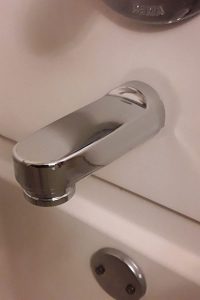
Non-Diverter bathtub spouts are installed in bathtubs where you only water to flow out through the spout, and never divert to the showerhead. These types of spouts do not have a knob at the top.
A non-diverter bathtub spout is installed in bathroom with 2 faucets, one for the bathtub and the other for the showerhead. These type of style is very common in modern bathtubs or remodeled ones.
3. Slip-On Bathtub Spouts
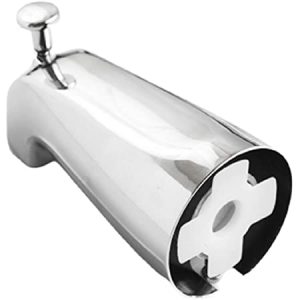
Slip-on bathtub spouts are connected to the water supply line using a screw at the bottom of the spout. They are the easiest to remove and install. The only tool you need is an Allen wrench to loosen/tighten the screw.
Ideally, slip-on bathtub spouts are installed on a ½-inch water supply pipe (usually copper) which must be of the correct length and without dents/burrs. You must therefore be very careful while removing the old one to prevent damaging it. A burred water pipe will often cause leaks.
How to Remove a Slip-on Bathtub Spout
- Plug off your bathtub drain to prevent anything from falling down the drain.
- Check if the spout is caulked to the wall. If so cut the caulk with a putty knife.
- Use the correct Allen wrench to screw out the screw from underneath the spout. Note that you don’t have to remove the screw all the way out but you need to make sure that it is completely detached from the pipe to avoid burring it.
- Grab the spout with both hand and pull it out gently. If it is not coming out freely stop and make sure that the screw is completely loose. If the spout has been in there for a couple of years, it will not come out smoothly. Twist it right and left as pull you it out.
How to Install a Slip-On Bathtub Spout
Make sure that you buy a spout that will fit the size of the pipe you have on the wall. Although you can cut a long pipe or add an adapter to a shorter one, buying the right size is just the right thing to do.
New bathtub spouts come with these specifications. What you want to see on the spout’s specification sheet is the recommended pipe length and diameter of the pipe. The type of threads also matter. Slip-on tub spouts will need a 1- 2 7/8 inches pipe in length.
Here is how to install a slip-on bathtub spout:
- Inspect the condition of the pipe. If there are mineral deposits, corrosions or burrs use an emery cloth to smoothen it.
- Slide the new bathtub spout until it rear touches the wall. Make sure it is properly aligned, so that water pours straight into the tub and not sideways.
- Put a screw underneath it and tighten it in place.
- Caulk the spout to the wall if so needed.
4. Threaded Bathtub Spouts

A threaded bathtub spout also known as a screw-on spout does not feature a screw but is instead threaded on the pipe. You should be very careful when installing or removing this spouts so that you don’t strip the threads on the pipe or remove the finish with a wrench.
There are 3 types of threaded bathtub spouts. They include:
- Front-end threaded tub spout – This type of spout can be used in a bathtub valve without a shower or one with a shower diverter built into the tub valve.
- Rear-threaded tub spout – A rear-threaded also known as wall-ended bathtub spout is more versatile than the front-end threaded spout. It can be connected to a ½ or ¾-inch spout stub-out nipple at the wall end of the spout. Rear-threaded tub spouts can be used with the usual shower diverters or even with a secondary outlet that allows the use of hand-held showers.
- Telescoping tub spouts – Telescoping threaded bathtub spouts as their name suggest affords you some flexibility by letting you make adjustments of up to 1 inch from the finished wall. You can therefore push them away or towards the wall within the range of 1 inch. They attach to ½ or ¾ nipple.
How to Remove a Threaded Bathtub Spout
- Check if the spout is caulked to the wall. If so cut the caulk with a putty knife.
- Wrap a rag or duct tape around the spout to avoid scratching off its finish. Grab it with an adjustable wrench or channel locks and turn it counterclockwise.
- If the channel locks/adjustable wrench prove insufficient upgrade to a pipe wrench and remove the spout.
How to Install a Threaded Bathtub Spout
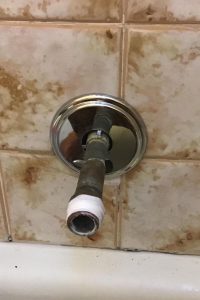
Again, make sure that your new bathtub spout is the same (in design not necessarily the brand) as the old one. This will save you the trouble of having to use an adapter or cutting the pipe.
In essence front-ended threaded spouts (non-diverter) will need a longer pipe than wall-ended (diverter) threaded spouts. If you are installing a front-end spout, measure the entire length of the pipe and order a spout of that size. Wall-end threaded spouts will need a nipple of not more than ½ inch while telescoping threaded nipples need a nipple of not more than 1 3/8 inches in length.
Here is how to install a threaded bathtub spout:
- Use a wire brush or toothbrush to clean the threads on the pipe coming from the wall.
- Wrap Teflon tape around the threads, preferably 4 wraps.
- Thread the tub spout on the pipe, starting off slowly. A good trick to thread properly is to first turn the spout to the left and after engaging the first thread turn it to the right. This way you avoid cross threading. Tighten the spout in place but not crazy tight.
- Caulk the tub spout to the wall.
5. Bathtub Spouts with Brass Adaptors
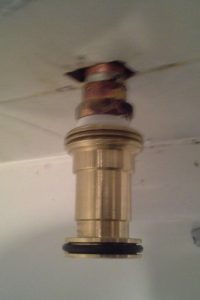
Sometimes you have a slip-on or threaded tub spout that instead of being connected directly to the water supply pipe on the wall it is attached to a brass adapter. They are rare though. The brass adapter is either threaded, slipped-on or soldered soldered on the pipe.
The front of the brass adapter is threaded while the rear has an O-ring to provide a water seal. When the adapter is connected to the pipe, the spout is then threaded on the adapter. The design allows you to adjust the position of the spout (back or forth) depending on the position of the brass adapter on the pipe.
How to Remove a Slip-On Bathtub Spout with a Brass Adapter
- If the spout is caulked to the wall cut out the caulk with a putty knife.
- To remove the bathtub spout from the adapter, turn it counterclockwise and get it out.
- Look for a screw on the brass adapter. Use an Allen wrench to loosen and pull the adapter out of the pipe.
- Pulling out the adapter might be harder especially if the adapter has been in place for long term. Grab it with both hands and pull it out as you turn it right and left gently.
How to Install a Slip-on Bathtub Spout with a Brass Adapter.
- Start by buying the correct size of tub spout and adapter.
- Once you have the correct spout and tub, use an emery cloth to remove any form impurity or burrs from the pipe.
- Push the brass adapter all the way to the rear of the pipe. Put in the screw and secure the adapter in place. Don’t overtighten the screw lest you dent the pipe.
- Push the new spout past the adapter O-ring and thread it on the adapter threads until it touches the finished wall. The spout should only be hand tight.
- Again, make sure that the spout is directly facing the bottom of the tub. If it tightens while facing up or sideways just back it up to the right orientation.
How to Remove a Threaded Bathtub Spout with a Brass Adapter
- Cut out any caulk on the wall with a putty knife.
- Grab the tub spout and turn it counterclockwise to disconnect it from the adapter. Once free remove it out.
- Use an adjustable wrench, channel locks or even a pipe wrench to loosen the adapter from the pipe. If you intend to reuse the adapter wrap it with a rag to prevent damaging it.
How to Install a Threaded Bathtub Spout with a Brass Adapter
- Clean the threads on the pipe with a wire brush or toothbrush to remove old Teflon tape.
- Wrap about 4 layers of Teflon tape on the pipe.
- Hand tight the adapter on the pipe. Once hand tight grab a wrench and tighten the adapter further, but not crazy tight.
- Push and thread the new tub spout on the brass adapter being careful not to damage the O-ring. The spout should only be hand tight. Make sure that you tighten it all the way to the wall but with the right orientation.
Soldered Bathtub Spouts with Adapters.
Sometimes instead of the adapter being threaded or screwed into the pipe it is soldered. Removing or installing a bathtub spout with a soldered brass adapter is not easy, and definitely not for everyone.
You first need to own a torch. Although some people recommend a hair dryer, a torch is the best tool for the job. Secondly, you need to know how to use a torch safely.
Most people with this type of spout will choose to call in a professional plumber and I think it is a good decision. Although it is a quick job for someone who knows what they are doing, a few things could definitely go very wrong.
My advice would be that after removing a tub spout with a soldered brass adapter, replace it with a slip-on or even threaded adapter. These 2 are way easier to work with than soldered adapters.






